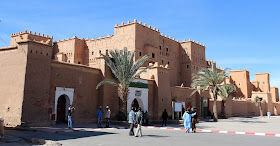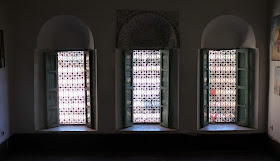Ouarzazate--just the name conjures up exotic visions--is a city of about 60,000 inhabitants in south-central Morocco on the north edge of the desert. The word "Ouarzazate" comes from a Berber word meaning "without noise" or "without confusion." That's not exactly how it appeared to us.
For example, I was a bit confused when we drove into town and saw this interesting art in the roundabouts and intersections:
Huh? It looks a little like Hollywood!
And yes, indeed, that's just what it is--the Moroccan Hollywood. One of the largest film studios (acreage-wise) in the world is here: Atlas Studios. Our guide had intended to take us on a tour, but the studios were closed for filming. (Oh, darn.)
Darn.
Some of the famous movies shot here include Lawrence of Arabia (1962), Patton (1970), the Michael Doughlas/Katahleen Turner movie The Jewel of the Nile (1984), The Last Temptation of Christ (1988), Jesus of Nazareth (1997), Gladiator (1999), Mel Gibson's The Passion of Christ (2004), and Kingdom of Heaven (2004), to name a few.
Well, since movie tour was off the docket, what else could we do? There is always shopping:
Our driver/guide Aziz took us to the Labyrinthe du Sud, which he promised was a very fine establishment with the best prices and the most authentic merchandise in town. Yeah, we'd heard that before, and we would hear it again and again.
We actually weren't that interested in shopping, and were glad we had already purchased a rug, thus sparing us from the "long version" of the rug presentation:
There was some nice jewelry, however, and we ended up buying a green malachite bracelet. I don't often wear bracelets, so they attached a chain to make it into a necklace. We also bought a turquoise and coral necklace.
Tourism is low in Morocco and the rest of the Middle East, and there weren't very many customers in the huge shop. This salesman seemed to be very happy with our purchase. (Bob thinks he looks like some man he remembers singing "The Lime and the Coconut" song in some commercial way back in the 1960s. Confused? Me too.)
In case you ever want to go there, here's their business card:
(If I ever get back to Ouarzazate, you guys at the Labyrinthe du Sud owe me one.)
Aziz also thought we might need to stop at some roadside shopping:
Nope. We didn't need any pottery.
Maybe some new clothes in this tres chic establishment?
Uh, nope.
Okay, Aziz said there was one more place to go:
The Kasbah!!
A kasbah is a fortress-like building, a defensive center for the community and a place a wealthy man can keep his family safe from harm. Some kasbahs are like a condominium complex and could house multiple families. With a maze of almost 300 rooms, the Taourirt Kasbah in Ouarzazate is enormous. At one time it was considered the largest kasbah in Morocco. Only part of it has been restored with UNESCO funds, and that's the only part we were shown.
Our guide said this adobe castle was built in the 17th century for a pasha with 24 wives, but my own research says it was built in the 19th century by the Glaoui Dynasty, a clan that controlled most of West Africa in the 19th and 20th centuries until Morocco achieved its independence in 1956. This kasbah housed the second tier of command rather than the Grand Poo-bah himself, but I'm sure one of those guys was a pasha with lots of wives.
Like so many Moroccan structures, there is a large central courtyard. In fact, there are more than twenty riads that make up Taourirt Kasbah, each likely having its own courtyard:
As soon as we went through the main entrance, we acquired a friendly guide (whether we wanted one or not). I don't recall there being an admission fee, so paying him a small fee was fine with us. Here he demonstrates Fatima's hand, the ubiquitous Moroccan symbol:

He identified some of the larger rooms as "harem rooms":
I especially loved this peacock fan, which we didn't see anywhere else, above some of the windows and niches. The colors remind me of the colors used in Egyptian tombs:
Impressive architectural design allows for cross-breezes. In addition, there is an open central core that allows air to circulate through the center (but probably caused mothers of young children no end of problems). That grill at the bottom of the picture prevents today's visitors from falling more than one floor:

The ceiling's skeleton is exposed in some rooms. I didn't write down the details, but I think one of these ceilings is in the room that served as a sauna.
Here is my pasha in the kasbah:
 |
| Detail of tile from picture above |








































Such decorative surfaces! I was also impressed that the outside, seemingly mud walls, were also decorated. Re: the shopping; I just read an article on minimalism in today's consumer world, but sounds like these fellas didn't get the memo. Nice jewelry, though!
ReplyDeleteI like the jewelry too, particularly the simpler malachite necklace. And the "lime and the coconut" guy in the blue outfit was pretty cool too.
ReplyDeleteI love the colorful shopping and the beautiful Kasbah. Don't love the multiple wives and no public appearance parts. How did the family get food and clothing without being able to go out in public and shop?
ReplyDelete